| کد مقاله | کد نشریه | سال انتشار | مقاله انگلیسی | نسخه تمام متن |
|---|---|---|---|---|
| 5111316 | 1483485 | 2017 | 10 صفحه PDF | دانلود رایگان |
عنوان انگلیسی مقاله ISI
Consumer response to price changes in higher-priced brands
ترجمه فارسی عنوان
پاسخ مصرف کننده به تغییرات قیمت در مارک های با قیمت بالا
دانلود مقاله + سفارش ترجمه
دانلود مقاله ISI انگلیسی
رایگان برای ایرانیان
کلمات کلیدی
قیمت، قابلیت ارتجاعی، آزمایشی مصرف کننده،
موضوعات مرتبط
علوم انسانی و اجتماعی
مدیریت، کسب و کار و حسابداری
بازاریابی و مدیریت بازار
چکیده انگلیسی
Price elasticity is a widely used measure of consumers' willingness or ability to pay for goods and services. This research examines the price elasticity of high-priced brands. We define high-priced brands as those that sell at or above the price point at which consumers begin to consider that product to be luxurious or premium in the category (Kapferer et al., 2014; Sjostrom et al., 2016). More specifically, we use high-priced wine brands as the context for this research. Wine is an ideal product to use because it has a wide price range, and can be purchased for various consumption situations. When prices are high we anticipate that elasticities may no longer function as they do in everyday consumer packaged goods markets. Instead, they might become smaller or possibly even positive if consumers are prepared to pay for the quality they desire. We employ stated choice experiments to investigate how Situational Factors, Consumer Factors and Contextual Factors influence price elasticities for high-priced wine brands in Australia. Results are that price elasticity estimates for the high-priced brands in this study are â1.8 on average. This is lower than the commonly reported figure of â2.6 for brands in general; however, in one part of the experiment respondents chose for a 'high-importance' occasion. Smaller price elasticities were found when (1) the perceived importance of the consumption situation was high, (2) among regular high-priced wine buyers, and (3) among brands with a higher initial price position. These results demonstrate that the patterns of price elasticity for high-priced products are mainly similar to that for other FMCG products, but consumers are slightly less responsive.
ناشر
Database: Elsevier - ScienceDirect (ساینس دایرکت)
Journal: Journal of Retailing and Consumer Services - Volume 39, November 2017, Pages 1-10
Journal: Journal of Retailing and Consumer Services - Volume 39, November 2017, Pages 1-10
نویسندگان
Ava Huang, John Dawes, Larry Lockshin, Luke Greenacre,
